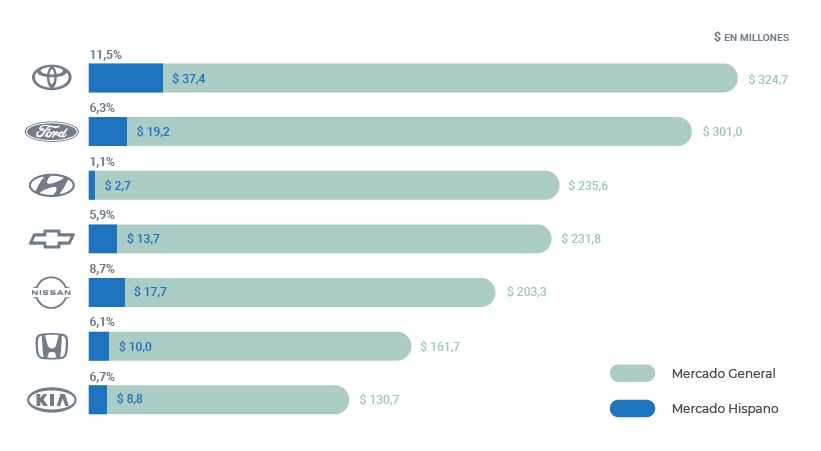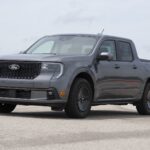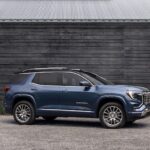On April 23, 2021 General Motors announced that it had transformed its approach to diverse media relationships. This was in response to allegations of racism toward African-American owned media from media moguls like Byron Allen. The press release, however, included specific goals and commitments for African-American-owned media but nothing regarding Hispanic-owned media. When approached by Drive Latino for more details regarding its goals for Hispanic-owned media, GM had no answer. It may seem like GM gave Allen what he wanted, but the truth is that manufacturers like GM have much more to give, not only to African-American-owned media outlets, but also to Hispanic-owned media.
According to the Oxford Languages/Google, racism is defined as: "the ideology that defends the superiority of one race over others and the need to keep it isolated or separated from the rest within a community or a country."
This can be done in many ways like vocalizing, segregating, and also with the denial of economic power. Because advertising dollars are not spent evenly among all radio, television, and Internet companies in the United States, it could be argued that advertising patterns in the industry are racist.
The origin of the issue of racism in automotive brands
As mentioned earlier, the situation came to the fore in March of this year when Byron Allen, founder, president and CEO of Allen Media Group, as well as six other African-American businessmen, placed an ad in the Detroit Free Press and later in The Wall Street Journal, where they accused GM and particularly its CEO, Mary Barra, of promoting racist acts.
The ad featured an open letter in which Allen argued that General Motors spends more than $3 billion on advertising annually and that only 0.5% goes to African-American-owned media companies. GM later corrected that figure to 2%.
But the strongest allegation from Allen toward Barra came at the beginning of the letter. “You have consistently refused to acknowledge us, over time and after multiple requests … the very definition of systemic racism is when you are ignored, you are excluded, and you do not have a true economic inclusion,” he said.
Allen asserted that when GM has the option of buying advertising from two media outlets that reach the same audience (one owned by whites and the other owned by African Americans), the auto company regularly leans toward the company whose owners are of white, denying economic inclusion to African American-owned media. According to Allen, this is in effect, systematic racism. The same can be said of GM’s treatment of Hispanic media, where the bulk of advertising is spent on non-Hispanic-owned television. The exclusion is further enhanced by the fact that Hispanics buy more vehicles in the US than any other sector of the population.
The truth is in the numbers
For more than a year Autoproyecto.com in conjunction with Drive Latino has been conducting an investigation on the Hispanic impact on the automotive industry and how Hispanics contribute to good vehicle sales in the US and managed to keep of many car companies afloat during the economic shutdown due to COVID-19 in 2020.
Sales in the African American market are 8%, while sales in the Hispanic segment are 15 %. In GM's case, sales in the African American sector have been falling year after year -3.9%, while the general market is at 0.4%, and sales to the Hispanic market have increased to a healthy 14.9%, demonstrating the importance of Hispanic buyers to GM.
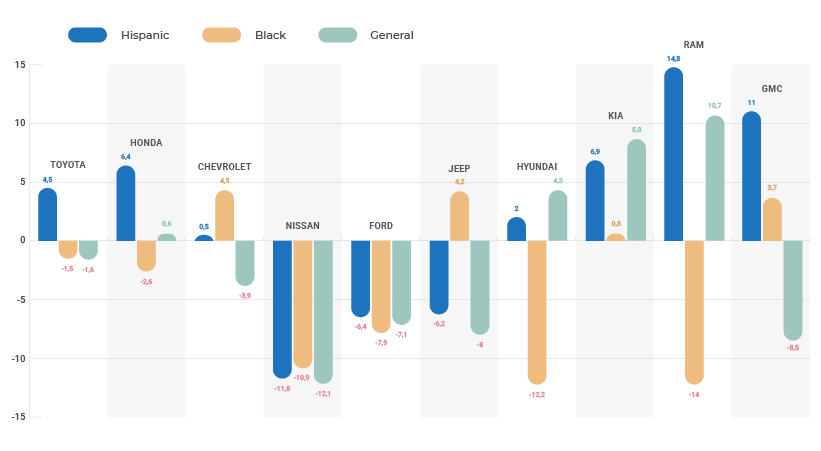
Vehicle registration data shows that Hispanics lead in automotive sales growth Source: IHS Markit
The latest census projects that the US Hispanic population, the largest minority population in the country, has increased to nearly 20% but contrary to that trend, automotive companies give less support to Hispanic communities, allocating zero economic resources to the media that represent them and, as if that were not enough, they are not hiring or promoting Hispanic employees. The 2020 Census also projects that Hispanics will double the African-American population by 2050.
Like African-American owned media, Hispanic-owned media suffers from the same economic exclusion. According to the 2020 Census, 19.1% of all businesses are owned by minority groups and 5.4% of businesses in the US are Hispanic-owned.
Information released by IHS Markit states that, in 2020, 29% of new registered vehicles were purchased by multicultural groups (Hispanic, Asian, African American). Furthermore, this figure has been increasing since 2011. According to IHS Markit, Hispanics currently make up more than half of the multicultural market, accounting for 68% of the industry's growth volume from 2011 to 2020.
So if Hispanics sales growth rose from 10% to 16% in 2020 and has also remained above 4% since 2019, according to information from IHS Markit, why did GM agree to increase advertising to African-American-owned media from 4% to 8% in the next six years, but will not provide specific goals for Hispanic-owned media?
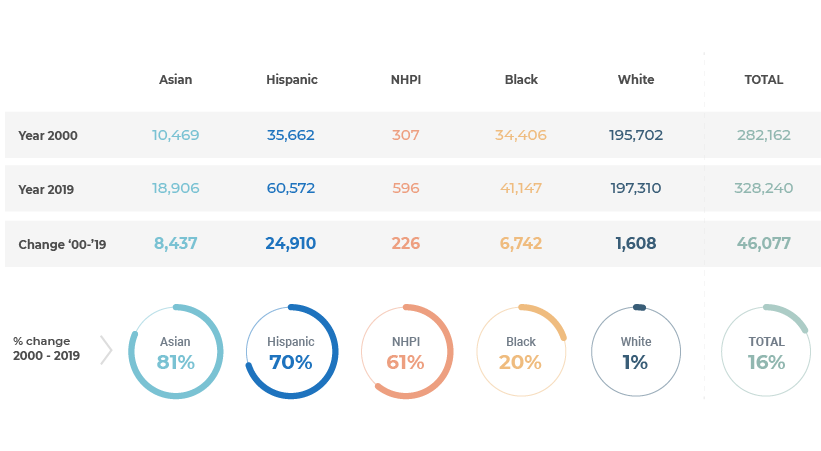
Exponential growth that the Hispanic population has had in recent years. Source: Pew Research
According to Hispanic Motor Press, a nonprofit foundation created to educate Hispanic consumers about the auto industry, no automotive company earmarks part of its advertising spending to Hispanic-owned communication companies with the exception of Autoproyecto, sister outlet to Drive Latino.
“You cannot argue with the fact that the Hispanic consumer is a significant driving force in terms of new car purchases,” says Ricardo Rodriguez-Long, Hispanic Motor Press founder and CEO. “Just look at the statistics. However, it appears that we have reached a point where automakers do not support Hispanic media that speak directly to potential buyers. Without consistent advertising revenue, the media cannot survive.”

Hispanic market share has increased with an upward trend, while sales to the African American sector have remained very stable. Source: IHS Markit
GM is not alone
Sadly, GM’s lack of interest in supporting Hispanic-owned media is not the exception but the rule. Autoproyecto also contacted Ford, Honda, and Stellantis regarding this issue and all but Stellantis expressed support for the Hispanic market but without specifics
Dan Flores, corporate spokesman for the company, said, “General Motors is committed to partnering with diverse owned media organizations, including Hispanic owned media and media targeting Hispanic consumers. We have increased our planned spending with multi-owned media and media targeting Hispanic consumers across our family of brands.
Ford responded, “Ford has had a long-standing commitment to the Hispanic communities and advertising in the Hispanic media is an important component of that strategy.”
In the case of Honda, they commented, “We are working cohesively to determine the right strategies to reach Hispanic car buyers and, as a result, we have increased activities with the Hispanic market. We will continue to invest to reach this important market. However, for competitive reasons, we do not disclose our media spending by audience or total."
Juan Torres, head of national multi-cultural advertising for Stellantis commented, "We appreciate the support of all media outlets within the multicultural landscape. Our media partner selection criteria at a campaign level are driven by many factors including but not limited to, audience consumption and behavior, inventory availability, ad formats, pricing and available buying models. We regularly evaluate the marketplace/business needs and adjust our selections and practices accordingly."
These responses imply that Hispanic-owned media is not seen as competitive or viable but that ignores their impact from the trust that they build with Hispanic consumers. We also want to note that as of earlier this year, Ford has become an advertiser of Autoproyecto but not of any other Hispanic owned automotive media.
Hispanic media need opportunity not charity
Regarding visitor traffic, many Hispanic-owned Internet sites outperform English-language pages, such as KBB.com, Car & Driver or Motor Trend and in a language that allows them to reach a much wider audience. Yet these sites receive generous support through advertising while Hispanic sites do not, another example systematic racism.
Just last year more than $159 million was spent in Univision and NBC Telemundo, which are non-Hispanic owned corporations. Autoproyecto estimates that more than $250 million is allocated annually to media directed towards Hispanics but less than 0.0001% goes to companies owned by Hispanics, further proof of racism among automotive brands.
For its part, Chevrolet spends more than $231 million on general market advertising, allocating $13.7 million to the Hispanic market but not a single dollar to Hispanic-owned media. Hispanic car buyers, however, make up 14.9% of Chevrolet's sales.
Hispanic car sites survive on marketing money from auto companies. Only through this money can they pay all the members who make the content of each site possible and who can report on the relevant issues in their communities from an authentic perspective.
Without the investment of money, Hispanic media cannot access the economic growth given to mainstream media and as Allen says, this economic exclusion is racist.
To correct this inequity, Drive Latino suggests that GM set a goal of investing a minimum of 20% in resources, from advertising to hiring, in the Hispanic community.
This is easily justified by the support Hispanic car buyers give the industry.
While the auto industry decides what direction it will take regarding its investment in Hispanic-owned media, Hispanic car buyers can also help nudge them in the right direction by voting with their dollars the next time they buy a car.
For more details about the state of investment in Hispanic-owned media, check out the series of reports from Impacto Hispano.

